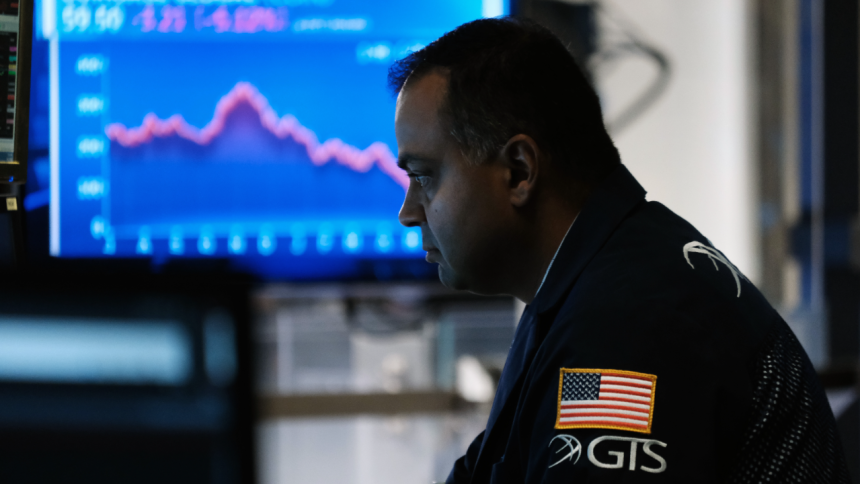While it can be defined in a couple of ways, put simply, a recession is a significant and sustained decline in economic activity that persists for months or even years. Worries about a pandemic-induced recession have swirled in economic circles for years now, being top of mind for economists as the Federal Reserve raised interest rates to historic levels to combat inflation.
But despite rising interest rates, the U.S. market remained resilient and job numbers were strong. Up until now, that is.
Fears of a recession were renewed on Friday following a key employment report from the Department of Labor, which indicated that job growth in July was much worse than economists had previously predicted. At the same time, unemployment rose to 4.3 percent, the highest it has been since October 2021.
This report sent waves of panic to investors, and by Monday morning, a global market sell-off had left the Dow Jones Industrial Average, Nasdaq Composite and S&P 500 in shambles. Even Japan’s Nikkei Index tanked, hitting its lowest level since 1987.
But don’t get swept up in the noise. Experts say few recessions are like the Great Recession and coronavirus pandemic-induced dip, and today’s economic situation is far different.
“If recession risks have risen a bit, that’s still far from a certainty in the short and intermediate terms,” says Mark Hamrick, senior economic analyst at Bankrate. “Even so, recessions and expansions are inevitably part of economic cycles. Their timing, depth and duration vary. These risks have been with us over the past couple of years as interest rates have risen in response to historically high inflation.”
Economists say the odds of the U.S. economy entering a recession by the end of the second quarter of 2025 are at 32 percent, according to Bankrate’s Q2 Economic Indicator Survey. While it may seem a bit bleak, there’s at least some reason to believe the recent economic slowdown isn’t the worst-case scenario.
All of that means, understanding recessions is more crucial now than ever, so you can prepare your personal finances wisely for any economic event, downturn or not.
What is a recession — and what isn’t?
You might have heard that a recession is when the financial system contracts for two consecutive quarters, as reflected in gross domestic product (GDP) — the broadest scorecard of the U.S. economy. Experts, however, say that oversimplifies it.
“That’s the rule of thumb that’s often been used,” says Eric Swanson, economics professor at the University of California, Irvine, who spent 10 years at the Fed. “But the last couple of recessions, it’s not quite been true.”
Technically speaking, a recession is when the National Bureau of Economic Research’s Business Cycle Dating Committee says so. That bloc of eight research economists has the sole authority of declaring when recessions start and end. Their official definition claims that a significant decline in economic activity across the financial system for longer than a few months marks a downturn.
The Business Cycle Dating Committee doesn’t just look at GDP. It also pays attention to:
- Real personal income excluding transfer payments;
- Two Department of Labor measures of employment (a household and business survey, conducted monthly);
- Consumer spending adjusted for inflation;
- Wholesale-retail sales adjusted for inflation; and
- Industrial production.
“There is no fixed rule about what measures contribute information to the process or how they are weighted in our decisions,” according to the committee.
Officials have their reasoning. The simplest is that data is regularly adjusted and revised. GDP, for instance, is published three total times over a two-month period before it’s finalized. By then, data could tell a completely different story.
Economists also stress that you can’t infer a trend just from a single data point. In December 2020, for example, the U.S. economy lost 115,000 jobs while the broader economy chugged along from the pandemic-induced recession. Meanwhile, the U.S. economy actually contracted in the first quarter of 2014, yet it wasn’t even halfway through the longest expansion on record at the time.
The committee has also declared a recession without seeing two subsequent quarters of decline. Case in point: The dot-com boom and bust, when the economy only shrank for one quarter.
“Most of the recessions identified by our procedures do consist of two or more consecutive quarters of declining real GDP, but not all of them,” according to the committee.
When are recessions declared?
Americans likely won’t know the U.S. economy is in a recession until it’s well underway, and they’re also unlikely to know right when a downturn officially ends.
For instance, officials didn’t officially declare the Great Recession had begun until December 2008 — a year into the downturn. Americans and economists had even longer to wait for the coronavirus pandemic’s official end date: 15 months after the fact.
Economists do have popular recession signals. A popular one, known as the “Sahm rule,” suggests the economy is in a recession when the unemployment rate rises by 0.5 percentage points from its previous 12-month low.
Part of the reason why recessions are tricky to spot is because data is released with a lag.
Yet, the committee’s definition of a recession implies two important points about spotting a downturn: A wide variety of data has to generally follow the same direction (down), and that movement has to persist for a longer stretch of time. When multiple data points start to edge down, that’s when Americans can infer that a contraction might be afoot.
What causes a recession?
If knowing when the U.S. economy is in a recession is a difficult task, predicting what causes a recession is even harder — if not impossible.
No one foresaw a global pandemic wrecking the longest U.S. expansion on record. Instead, most economists wondered whether it might be the trade war between the U.S. and China or the Fed tightening rates too much that officially tipped the financial system over.
Recessions have differing variations, degrees and depths, and each of them is caused by something different; however, they generally happen when there’s some sort of external shock — either on the demand or supply side.
In the early 1980s, the Fed clamped down on boiling inflation and inflation expectations by intentionally causing a recession. In 2001 and 2008, busts in the stock and housing market were to blame.
“If you talk to professional economists, there’s no tendency for booms to die of old age,” says Swanson, who is a research associate at the NBER. “There’s always going to be something someday that disrupts the economy.”
The same generally goes for predicting how severe a downturn may be. Not all recessions have the same flavor; some come with greater impacts than others. Joblessness surged to 10 percent in the aftermath of the Great Recession, with almost 8.7 million jobs lost between December 2007 and February 2010. That was the most severe recession since the Great Depression — until it was eclipsed by the coronavirus pandemic more than a decade later, which put nearly 1 in 4 out of work and cratered nearly 22 million jobs.
“When thinking about recessions, the catalyst determines the severity, the length and the subsequent recovery,” says Ryan Sweet, chief economist at Oxford Economics. “When you have a financial crisis, a recession is pretty significant and long, and the recovery is slow. You have to repair household balance sheets; you have to repair corporate balance sheets. The next recession, if we do have one, it’s going to be very mild. It shouldn’t be that long either because there’s no glaring imbalance in the economy.”
Why are recession risks high right now?
The future is impossible to predict, but today’s major recession risks all have to do with high inflation — or rather, what has to happen because of it. Over the last couple of years, Fed officials raised interest rates at the fastest pace in four decades to cool inflation.
Despite initial worries that increased interest rates would inevitably throw the U.S. economy into a recession, job growth and unemployment remained surprisingly resilient. But July’s job numbers as reported by the Department of Labor indicates that may be changing.
While experts did say the U.S. economy has a 32 percent chance of entering a recession before the end of the first half of 2025, this is a good deal lower (more than 10 percentage points) than the prediction at the start of the year, according to an earlier Bankrate report, economists said there was a 45 percent chance of entering a recession by the end of 2024
While the price on many items, including food, have remained stubbornly high, inflation has improved quite a bit, paving the way for a possible Federal Reserve rate cut in September.
“We’ve seen some economic data of late pointing to a softening job market,” Hamrick says. “This should be viewed within the context of a U.S. economic expansion that has exceeded expectations and also after the job market had been red-hot. A 4.3 percent unemployment rate is far from recession levels. We can assess whether the risks of a broader slowdown have risen and also whether the current level of the Federal Reserve’s benchmark interest rate is overly restrictive. That is something Federal Open Market Committee members will be grappling with in the months ahead.”
What a recession means for your money
Generally, recessions mean periods of elevated joblessness, reduced spending and pessimistic outlooks. Any hit to employment can make it harder to afford both the items you want and need — but so can high inflation, underscoring why Americans might be feeling as if they’re living through a downturn already, even despite half-century low unemployment.
One can understand why a strong job market has been regarded as irrelevant for those who are employed but struggling to pay for the things they need or want. For many Americans, the experience of high inflation has been significant as it has reduced their buying power.
— Mark Hamrick, Bankrate Senior Economic Analyst
Think about building an emergency fund and plan ahead to how you’d respond to a spell of unemployment. That might mean applying for unemployment insurance (UI) and staying in touch with your networks, who can let you know about job opportunities. It’s also important to evaluate your purchases in the months ahead and prepare for harsh economic times while the financial system looks like it’s still on stable footing.
“A recession will occur at some point,” Sweet says. “It doesn’t have to be next month or next year, but at some point, we will experience it.”
Bankrate writer Marcos Cabello contributed to an update of this story.
Read the full article here














